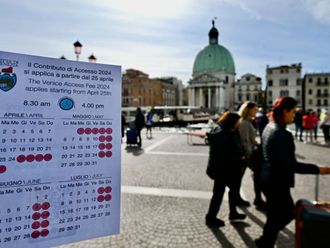
Torun, Poland: This medieval city on the banks of the Vistula River is known for two things: astronomer Nicolaus Copernicus and gingerbread cookies.
Copernicus was born here, although he would move as a student and live most of his life elsewhere. Yet it is the aromatic gingerbread cookie that is the more enduring export, spawning museums and hands-on bakeries dedicated to the popular Christmas treats and a debate over which cookie is best. Artisans have jealously guarded their recipes for centuries, and to this day the blueprint for authentic Torunskie pierniki remains shrouded in mystery.
“There is not just one recipe or one way of making pierniki,” said Anna Kornelia Jedrzejewska, curator at the Museum of Torun Gingerbread, the former factory of Gustav Weese, whose family baked pierniki there for generations. “The problem for us today is that the recipes are quite secret.”
The earliest reference to the cookies dates to 1380. The name pierniki is derived from the Polish word pieprz, or pierny, meaning packed with peppery flavour. The city’s location on the spice route from Asia to Europe, its abundance of fertile soil and a wealth of honeybees explain gingerbread’s three main ingredients: honey, flour (rye, wheat or a blend) and spices.
Great pierniki are all about the proper blend of spices: Too much cinnamon will make them too sweet, and too much ginger or pepper will make them too spicy, said Pawel Laskowski, a master gingerbread maker with Kopernik, which grew from the company the Weese family founded and is now the largest pierniki producer in Torun.
One of the earliest recipes for Torun gingerbread calls for honey, “as much as you like,” to be put in a bowl, heated with strong vodka and water, then skimmed until thick. That mixture is to be combined with a range of spices, lemon peel and some sugar.
“Up to the 19th century there were no proportions given at all,” said Rafal Boinski, who gives demonstrations at the Living Museum of Gingerbread here. “All the details regarding recipes were passed down through generations of bakers. Whenever you bake your cookies, they will never come out the same.”
Boinski suggests that cinnamon, ginger, black pepper, cloves and nutmeg are musts in terms of spices. Aniseed, cardamom, allspice and a little coriander are also often included.
“The proportions are down to you,” he said. “If you like it a bit more spicy, add more black pepper or ginger. If you’d rather have it sweet, more cinnamon and just a touch of black pepper.”
The region’s Museum of Torun Gingerbread recently opened a Laboratory of Gingerbread to study the taste and composition of gingerbread over the years.
Traditional pierniki are soft when they first come out of the oven and harden after that. The cookies should be put away in a moist place like a basement or kept in a metal or airtight container to soften. Fans say the cookies only get better with time, but if you want to speed the process, adding a wedge or two of apple or fresh ginger in the container will do the trick.
Kopernik sells a variety of pierniki, although most of its cookies are no longer made with honey because of the expense. At the factory, gingerbread masters still guard the secret spice mix and decide when to use the dough, which is stored in large metal bins, where it’s aged for up to a year.
“Sometimes it doesn’t work,” Jakub Kopczynski, marketing manager for the Kopernik company, said during a tour of the factory in November. “That’s why it’s so unique: Most people don’t mature the dough anymore.”
The job of gingerbread master has long been held by men because of the difficulty of working with the dense, heavy dough. Training for the job is likened to that of a winemaker, since selecting the dough relies on using the senses of smell and touch to know when the mix is ready. Traditionally, the soda or leavening agent would have been kneaded in at the end. Because dough used for molds is not leavened, it can hold a sharper design.
The elegant and intricate carved wooden molds that the cookies were made in hundreds of years ago were perhaps as important as flavour to the gingerbread’s popularity. The beautiful moulded cookies have for centuries been prized gifts, specially made for royalty and dignitaries. After a visit to Torun in 1825, the composer Frederic Chopin, 15 at the time, wrote to a friend praising the town’s gingerbread as better than the Gothic architecture and famous leaning tower.
While the moulded cookies are still sold in Torun, they are not common. The pierniki sold in most shops and made at home tend to be cut in simple shapes like hearts or clubs — or shapes associated with Christmas — and have a slightly dry, caky structure. Often they are glazed with sugar or chocolate; sometimes they are filled with jams, with plum a popular option.
One of the most popular shapes is the Katarzynka, or Little Kate, and several legends surround how it came into existence. One holds that a well-known Torun gingerbread maker fell ill and asked his only daughter, Catherine, to bake the gingerbread. Unable to find the medallion mold needed, she cut circles, which she put in the oven in two rows of three. The circles merged together, creating the scalloped shape that remains popular today.
A small number of pierniki stores dot the streets of Torun, one of the few cities in Poland that escaped the devastating bombings of the Second World War. In one shop near the Old Town Hall, pierniki abound, floor-to-ceiling in packages and decorative tins with box after box of the cookies filled with seemingly every type of jam, including plum, apple and rose gel.
Both museums have hands-on demonstrations where visitors knead and roll out dough, which is then pressed into oiled molds. The design is then cut out and baked and given to visitors as a souvenir.
“Pierniki has so many faces, it’s hard to say, ‘This one is the best,’ ‘This is my favourite,’” Kornelia Jedrzejewska said. “Every generation brings something new to the recipes.”












